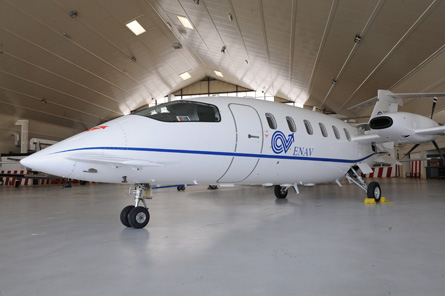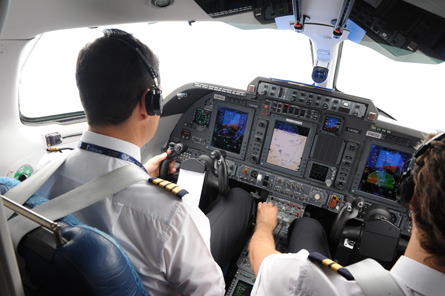Alberto Galassi quickly sketches two graphs on the whiteboard in his Rome office. The first - a sharp downward curve stubbornly anchored at the bottom - represents the business aviation market's sharp fall from grace during the past three years and current stagnation. The other - a mirror image - illustrates the glowing prospects for the special-missions market, including air ambulances, maritime patrol and flight inspection aircraft, explains the Piaggio Aero chief executive.
It is a market the Genoa-based maker of the P180 Avanti II believes it can crack in a big way. The $7 million twin-pusher turboprop - conceived in the 1990s as a fuel-efficient but aspirational midsize VIP transport, with a touch of Italian design classic about it - was never intended as a special-missions platform. Piaggio, however, has enjoyed some success in the market.
Of 220 P180s in service, 32 are in special-mission configuration, including 18 air ambulances and nine maritime/territorial surveillance aircraft. The Polish air rescue service and Royal Canadian Mounted Police use three P180s in medevac configuration; all the others are deployed by the Italian military or other state agencies.
 |
|---|
| BillyPix |
Galassi, however, believes this number can only grow as more governments and parapublic organisations look for lower-cost solutions to a range of surveillance and other mission requirements - something increasingly possible because sensors and other on-board systems have become much smaller and lighter in the past decade.
It means equipment which previously required a platform the size of a Boeing 737 or ATR can now be accommodated on a midsize business aircraft such as the Avanti II. He believes non-VIP variants will represent about half of Piaggio's deliveries within a few years.
Piaggio is so confident about market prospects it plans to develop two new extended-range variants of the P180 specifically for special mission, and is targeting a 2015 in-service date.
LAUNCH CUSTOMER
The company, which is majority owned by Abu Dhabi's state investment arm Mubadala and India's Tata group, hopes to announce a launch customer at next February's IDEX defence show in Abu Dhabi. Although Galassi will not reveal the customer, the fact Mubadala is fairly hands-on in terms of Piaggio strategy and the choice of IDEX provide some clues.
The flight inspections area is one Piaggio is paying particular attention to. At last November's Dubai air show, the company announced the delivery of the first of five P180s ordered by Flight Inspections and Systems (FIS), the Russian agency tasked with carrying out airborne inspections of ground-based navigation aids at the country's airports.
Negotiations are taking place for a follow-up order for up to 50 aircraft, which are likely to include the new variants, some of which may be assembled in Russia. FIS operates Soviet-era Antonov An-26s and An-24B turboprops.
Closer to home, the flight inspections arm of Italy's air traffic provider ENAV, which performs similar duties to FIS in Italy as well as under contract in Kenya, Malta and Romania, has just taken delivery of the third of three P180s, the first of which arrived in 2009.
The aircraft, which is fitted with an on-board mission system by Norwegian Special Mission, flies with a crew of three: a captain, first officer and flight technician. He sits at the console and takes readings from the ground-based navigation aids, including radar and instrument landing systems, analysing them in real time as the aircraft performs a series of orchestrated flightpaths over the airport.
Some 20 additional sensors on the fuselage, including a vertical camera on the aircraft's belly, record the radio signals being transmitted from below. If necessary, equipment can be calibrated by ground staff as the aircraft passes over using information from the on-board computer. The data provides the information civil aviation authorities need to re-certificate the equipment, most of which is required to be inspected every six to 12 months.
ECONOMY STYLE
The outfitting of the P180s' cabins and the installation of sensors were carried out at Piaggio's factory in Genoa. Aside from the console - which costs almost as much as the green aircraft itself - the Avanti comes with four additional economy-style seats - comfortable enough, but a far cry from the leather armchairs on the VIP version - and a rear lavatory. These allow ENAV to take a relief crew on missions far from its base at Rome's secondary Ciampino airport. ENAV is responsible for about 40 Italian airports.
The organisation, which employs a total of 18 pilots and eight systems operators, is also expanding its overseas activities, earlier this year signing contracts to validate and calibrate the radio signals from airport navigation systems in Kenya and Romania.
ENAV also carried out work in Libya earlier this year to get the air navigation infrastructure up and running again after the civil war. Based on this third-party success, the organisation is targeting a 30% increase in revenues next year, something that would necessitate a fourth P180.
The fleet of P180s will perform about 2,000h a year, roughly 700h each. A typical mission lasts about 3h-3.5h, with 6h the usual daily limit. A total inspection of an airport's equipment can take up to three days, including the flight to the city, although some are much quicker, often involving an urgent calibration of a single piece of misfunctioning kit.
The P180s replace older Cessna Citation jets, the last of which, a Citation VI, will be phased out this summer. ENAV's director of flight operations Capt Enzo Maria Feliziani says the P180s use about 400 litres (105 USgal) per hour - about half that needed by the Citations on a similar mission. Part of that is down to the on-board equipment - although the console adds 227kg (500lb), the kit is lighter than the previous-generation versions installed on the Citations. In addition, the acquisition cost of a new, similarly-sized Cessna Excel would be about twice that of the P180, says Feliziani.
 |
|---|
| BillyPix |
Back at Piaggio's Rome office, Galassi remains as downbeat about the immediate prospects for business aviation as he is optimistic about the special-missions market. It is one reason the company's long-mooted jet project remains on ice.
Although design work has been carried out on the project, Piaggio has signed up suppliers, and Galassi even spoke at the Dubai air show of a special-missions variant. He concedes: "You will not see a launch this year." The jet - thought to be based on a larger platform than the P180 - would take Piaggio into a highly competitive light jet segment in which several brands are struggling, including the Hawker 400XP and Premier IA and Embraer Phenom 300.
Neither does Galassi see much of a market for a VIP version of the extended-range P180: most executive flights on an Avanti are relatively short because of the cabin size, and most customers would not sacrifice speed for added endurance, he believes. "But never say never," he adds.
Joining ENAV for a low pass over Perugia
We joined an ENAV crew - headed by the organisation's flight operations director Capt Enzo Maria Feliziani and comprising a co-pilot and mission system operator - on a short flight inspection sortie over the small Perugia airport in Umbria, about 119nm (220km) north of ENAV's Rome Ciampino base.
The purpose of the flight was to check three aspects of the airport's navigation guides, and after completing the 26min journey from Ciampino we performed three manoeuvres: on most missions about 20 runs would be carried out, but all are a variation of the three basic sweeps.
The first, known as "alpha", involved a low-level approach, descending from 3,500ft to 50ft to test the glidescope. "Charlie six" is an arc between two points 45˚ from the runway axis, flown at 2,500ft. This is to check the localiser signal has sufficient width. The final manoeuvre, "lima" for level flight, is a loop from 2nm to 10nm from the end of the runway to test the width of the glidepath.
A debriefing following the flight, at which the flight inspection data was collated, confirmed all the equipment at Perugia was working well within official parameters.
Perugia's sleepy airport made it a relatively easy mission for the ENAV crew. At busier airports, the flight inspection division has to work closely with air traffic controller colleagues to slot in its test runs between arriving and departing airliners.
Source: Flight International



















